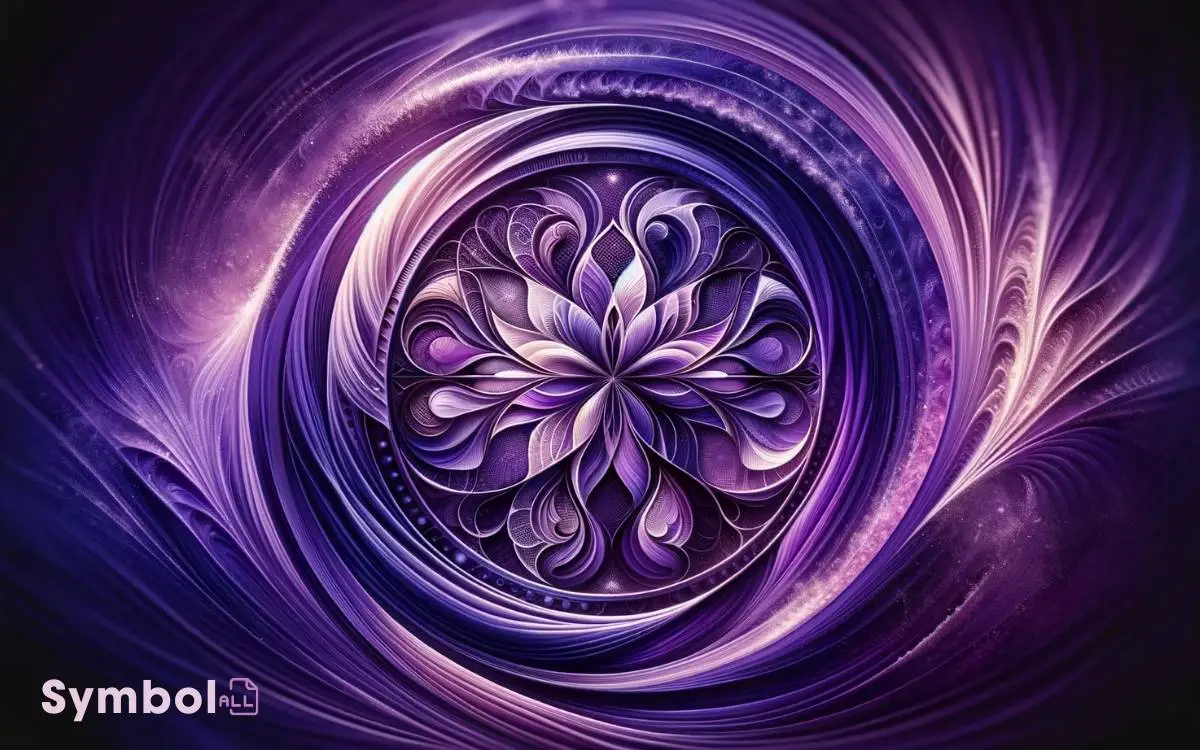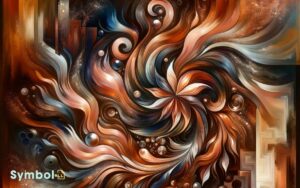Symbolism in the Color Purple: Pain, Struggle & Hope!
In ‘The Color Purple’, you’ll find purple isn’t just a color; it’s a narrator of pain, struggle, hope, and transformation.
Historically, it represents nobility and luxury, carrying a weight of sovereignty and exclusivity. Yet, beyond these royal connections, purple embodies spiritual awakening, resilience, and empowerment.
Its vibrancy signals a journey of liberation from oppression, inviting psychological growth and introspection.
For characters, it symbolizes a reclaiming of dignity, a reflection of inner transformation, and a bold step towards self-acceptance.
Exploring its multifaceted symbolism unravels a deeper understanding of the narrative’s soul, guiding you closer to the heart of its vibrant tapestry.

Key Takeaway
Historical Significance
The examination of color symbolism in ‘The Color Purple‘ reveals a multifaceted historical significance, deeply ingrained in the African American experience and cultural expression.
You’ll find that colors within the narrative aren’t just aesthetic choices; they’re loaded with historical weight and meaning.
They serve as silent narrators of pain, struggle, but also of hope and liberation. By delving deeper, you uncover how these colors reflect the societal norms and racial prejudices of the time.
They’re not merely background elements; they’re integral to understanding the characters’ journeys and the broader cultural context.
This exploration allows you to grasp the profound ways in which color symbolism enriches the narrative, making it not just a story, but a vibrant tapestry woven with the threads of history.
Royal Connections
You’ll observe that the color purple carries a rich tapestry of royal significance, historically symbolizing nobility and sovereignty.
This association with luxury and exclusivity has evolved, yet remains firmly rooted in contemporary symbols of status and wealth.
Analyzing this shift offers insights into how cultural perceptions of color influence societal values and identity.
Historical Royal Significance
Throughout history, purple has symbolized royalty, suggesting a deep, complex connection to power and luxury in various cultures.
This association wasn’t accidental but deeply rooted in the rarity and cost of purple dye. Ancient processes for creating this dye were laborious and expensive, making purple textiles exclusive to the elite.
| Culture | Significance of Purple |
|---|---|
| Ancient Rome | A symbol of power and imperial authority |
| Byzantine Empire | Worn by emperors to signify divine rulership |
| Medieval Europe | Used in royal garments to denote high status |
In these contexts, purple wasn’t just a color but a marker of socio-political hierarchy. It communicated wealth, power, and rarity, traits that were integral to the identity and authority of royals.
This historical backdrop enriches our understanding of purple’s enduring symbol of nobility.
Modern Luxury Associations
Moving beyond its historical roots, purple’s association with luxury continues to influence modern perceptions, especially where royal connections underscore its enduring prestige.
You’ve seen it subtly woven into the branding of high-end products, from luxury cars to designer fashion.
This isn’t merely a coincidence; it’s a calculated nod to the color’s regal lineage. Companies leverage purple to evoke a sense of exclusivity and superiority, tapping into the subconscious associations we hold.
But it’s not just about material goods. Events and institutions that wish to convey a sense of importance or tradition often incorporate purple into their visual identity.
This deliberate choice speaks volumes, highlighting how the color’s royal connotations aren’t just historical footnotes but active elements in contemporary symbolism, shaping how luxury is perceived and experienced in the modern world.
Spiritual and Mystical Aspects
You must consider the pivotal role color symbolism plays in representing spiritual awakening and mystical power within ‘The Color Purple’. You must consider the pivotal role color symbolism plays in representing spiritual awakening and mystical power within ‘The Color Purple’. The novel uses shades like purple and other vibrant hues to signify resilience, transformation, and divine connection, underscoring the characters’ journeys toward self-discovery. These colorful symbols of hope not only reflect emotional growth but also serve as powerful reminders of the beauty and grace that exists even in the most challenging circumstances. Through these vivid metaphors, Alice Walker invites readers to witness the profound ways in which color transcends the ordinary to symbolize spiritual enlightenment.
Analyzing how colors facilitate the characters’ journeys towards spiritual enlightenment reveals the narrative’s depth.
This examination uncovers the nuanced ways in which color acts as a conduit for both personal transformation and the broader interpretation of mystical energies.
Spiritual Awakening Significance
In ‘The Color Purple,’ spiritual awakening serves as a transformative force, guiding characters toward self-discovery and empowerment amidst their struggles. This process is deeply symbolic, offering you a nuanced understanding of spiritual rebirth.
The following aspects are central to interpreting its significance:
- Liberation from Oppression: Characters find strength in spiritual epiphanies, breaking free from societal and personal shackles.
- Connection with the Divine: Spiritual awakenings foster a profound rapport with a higher power, emphasizing the soul’s resilience.
- Journey of Self-Discovery: These awakenings catalyze a quest for identity and self-worth beyond external validations.
- Empowerment through Faith: Faith acts as a cornerstone for characters’ empowerment, instilling hope and courage to confront life’s adversities.
Understanding these elements deepens your appreciation for the spiritual dimensions woven into the narrative’s fabric, highlighting the pivotal role of spirituality in personal transformation.
Mystical Power Interpretation
Alice Walker’s novel ‘The Color Purple’ intricately weaves mystical elements into its narrative, offering a profound interpretation of spiritual and mystical powers as vehicles for personal and communal transformation.
You’ll find that the color purple itself symbolizes a higher consciousness and spiritual awakening, pivotal for the characters’ journeys.
This isn’t just about the aesthetic appeal; it’s a deep, symbolic representation of power, wisdom, and dignity.
| Symbol | Meaning | Impact |
|---|---|---|
| Purple | Spirituality | Empowerment |
| Flowers | Growth | Hope |
| Letters | Knowledge | Liberation |
Psychological Impact
Exploring the color symbolism within ‘The Color Purple’ reveals its profound psychological impact on characters and readers alike.
This analysis extends beyond mere aesthetics, tapping into the very psyche of those engaged with the narrative.
Here’s a deeper understanding:
- Empowerment: Purple symbolizes a journey of self-discovery and empowerment, mirroring psychological growth.
- Healing: It represents healing from past traumas, signifying emotional and mental recovery.
- Transformation: The color embodies transformation, reflecting the psychological changes the characters undergo.
- Resilience: Purple stands for resilience in the face of adversity, showcasing the psychological fortitude required to overcome obstacles.
These elements combined present an intricate tapestry of human emotion and psychological depth, inviting readers into a profound introspection of their own experiences and resilience.
Cultural Interpretations
Delving into ‘The Color Purple,’ one discovers that cultural interpretations of color greatly shape characters’ identities and narratives, revealing a rich mosaic of societal values and personal histories.
This spectrum isn’t monolithic; it varies widely across cultures, embodying different meanings and emotions.
In some societies, purple signifies wealth and nobility, derived from its rare and costly dye in ancient times. Yet, in others, it represents mourning and sorrow, a stark contrast to its regal associations.
These cultural nuances add layers to the narrative, influencing how characters perceive themselves and interact with the world.
You’ll find that understanding these interpretations not only enriches your reading experience but also offers a deeper appreciation of the complex web of human emotion and societal constructs that the color purple weaves throughout the story.
Fashion and Elegance
In ‘The Color Purple,’ the nuanced use of fashion and elegance strikingly reflects the evolving self-awareness and liberation of characters, particularly in how they express identity and resilience through their clothing choices.
As you explore further, consider:
- Clothing as a Form of Expression: Characters use fashion to signal shifts in power dynamics and personal growth.
- Color Symbolism: Purple, emblematic of royalty and spirituality, signifies transformation and empowerment.
- Historical Context: The attire reflects the era’s constraints and the characters’ defiance or compliance with societal norms.
- Personal Liberation: The evolution of the characters’ style mirrors their journey towards self-acceptance and liberation.
These elements collectively underscore the importance of fashion and elegance as profound vehicles for thematic exploration and character development within the narrative.
Literature and Art
How does ‘The Color Purple’ intertwine literature and art to enrich its narrative, revealing deeper layers of meaning and emotion?
This masterpiece leverages vivid descriptions and metaphors, painting a canvas that extends beyond mere words.
Through its pages, you’re not just reading; you’re visualizing a rich tapestry of settings and characters, each brushstroke adding depth to the story’s emotional landscape.
The novel’s artistry lies in its ability to transform words into images, making the reader feel as if they’re walking through a living, breathing gallery of experiences and histories.
This blending of literary and artistic elements not only enhances the storytelling but also invites you to explore the multifaceted symbolism of purple, beyond its surface, delving into the soul of the narrative.
Femininity and Empowerment
Exploring the rich tapestry of ‘The Color Purple,’ we find femininity and empowerment woven into the very fabric of its narrative, revealing how these themes aren’t just backdrop but central to understanding the protagonist’s journey.
This portrayal offers a nuanced exploration of the struggles and triumphs that define the female experience, particularly in the context of overcoming oppression and finding one’s voice.
To investigate further:
- Self-Discovery: The journey toward self-awareness and autonomy.
- Solidarity: The strength found in female friendships and communal support.
- Resistance: The act of defying traditional gender roles and expectations.
- Liberation: The ultimate attainment of freedom, both personal and collective.
Through these elements, ‘The Color Purple’ serves as a poignant commentary on the resilience and empowerment inherent in femininity.
Mourning and Remembrance
Delving into ‘The Color Purple,’ mourning and remembrance emerge as pivotal themes, reflecting the characters’ struggles to honor their past while finding a way toward healing and self-realization.
| Aspect | Impact on Characters | Symbolic Meaning |
|---|---|---|
| Loss | Drives personal growth | Cycle of life |
| Memory | Connects past and present | Bridge between generations |
| Letters | Reveals hidden truths | Power of voice |
| Clothing | Expresses identity changes | Transformation |
| Songs | Serves as emotional outlet | Cultural heritage |
Analyzing these elements reveals how mourning and remembrance serve not only as responses to loss but also as catalysts for empowerment.
They’re intricately woven into the narrative, showcasing the resilience of the human spirit. Through this lens, you’re invited to appreciate the depth and complexity of the characters’ journeys.
Nature and Environment
You’ll find that ‘The Color Purple’ intricately weaves the significance of purple flora into its narrative, symbolizing resilience and transformation within the natural environment.
This choice not only reflects the characters’ growth but also mirrors broader environmental impacts, urging a reevaluation of our interaction with nature.
Through this lens, the novel prompts a critical examination of how environmental changes and symbolic elements converge to shape the narrative’s core themes.
Purple Flora Significance
In ‘The Color Purple,’ purple flora embody a profound connection between the characters and their environment, symbolizing growth, transformation, and spiritual awakening.
These elements aren’t just background scenery; they carry a weight of significance that you, as an insightful reader, can appreciate on a deeper level.
- Growth: Purple flowers represent the characters’ personal growth from adversity.
- Transformation: Just as seasons change, the purple flora signifies the transformative journey of the characters.
- Spiritual Awakening: The color purple, often associated with spirituality, marks the characters’ awakening to a deeper understanding of themselves and their connections to the world.
- Resilience: Amidst challenges, the purple flora stands resilient, mirroring the characters’ determination to thrive.
These symbols enrich your understanding of the narrative, offering a layered exploration of the characters’ experiences.
Environmental Impact Reflection
Alice Walker’s ‘The Color Purple’ intricately weaves the natural world into its narrative fabric, reflecting a profound environmental impact that shapes the characters’ realities and their self-perceptions.
This reflection isn’t merely a crucial, breathing entity within the story, offering both solace and a mirror to the turbulence experienced by the characters.
The environment in Walker’s narrative acts as a silent witness to the characters’ struggles and triumphs, subtly influencing their journeys and evolution.
You’ll find that the natural setting isn’t just scenery; it’s an essential lens through which Walker explores themes of growth, freedom, and resilience.
Through this lens, you’re invited to see how deeply intertwined human emotions and environmental conditions can be, highlighting an often-overlooked aspect of our existence.
Modern Uses and Meanings
Exploring modern interpretations, it becomes clear that the symbolism of colors in ‘The Color Purple’ resonates with contemporary themes of empowerment and identity.
This nuanced representation extends beyond the narrative, infiltrating various aspects of society and culture.
Consider the following:
- Empowerment: Purple symbolizes the struggle for dignity and self-respect, reflecting movements that advocate for social justice and equality.
- Identity: It represents the discovery and affirmation of one’s identity, particularly in the context of gender and sexuality.
- Spirituality: The color embodies spiritual growth and the quest for understanding beyond the material world.
- Innovation: In technology and art, purple signifies creativity and the courage to challenge conventional norms.
These elements demonstrate how ‘The Color Purple’ continues to offer profound insights into the human condition, inspiring generations to seek authenticity and purpose.
Conclusion
In concluding, the color purple’s symbolism transcends mere aesthetic appeal, embodying a rich tapestry of meaning across cultures and epochs.
From its royal lineage to its spiritual significance, and its role in gender empowerment to environmental symbolism, purple’s narrative is deeply interwoven with human experience.
As you’ve seen, it’s not just a color but a powerful symbol that challenges and inspires. So, next time you encounter purple, pause and reflect on its profound layers. It’s more than a hue; it’s a story.






